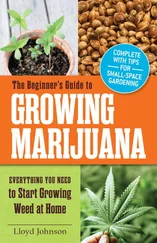I have a foolproof organic insecticide formula that kills all insects without harming my plants. It works on spider mites, thrips, gnats, and white flies, to mention a few of the most common indoor garden pests. Its active ingredient is Einstein oil, which is basically neem oil, from the neem tree, mixed with pyrethrums, which are made from chrysanthemums. Add a few drops of Safer’s Insecticidal Soap to the Einstein oil to help the solution stick to the plants. Einstein oil and Safer’s Insecticidal Soap are available at most hydroponics stores and garden supply stores and can be ordered online. Do not spray plants at the same time you fertilize, and remember, only spray cannabis in the vegetative cycle.
To make my all-natural insecticide, you’ll need:
• 1 teaspoon Einstein oil
• 2–3 drops of Safer’s Insecticidal Soap
• 4 ¼ cups water
• spray bottle or pressure sprayer
Then:
1. Add a few drops of Safer’s Insecticidal Soap to the water.
2. Shake the room temperature Einstein oil vigorously and then mix with the soap and water solution.
3. Pour solution into spray bottle.
4. Shake the solution repeatedly and do so regularly while using.
5. Spray the soil and wet the undersides of the leaves more than the tops.
6. Wait 10 days and spray again.
7. Keep repeating this cycle until all insects are gone.
This solution won’t hurt your plants. It is not so much the quantity or strength of the solution that you deliver to the plants that works — it is the repetition every 10 days. The first spray keeps the insects from breeding and kills most of the adults but does not damage the eggs. The eggs usually hatch within 10 days, so that is why you have to repeat the spraying cycle every 10 days. It might take several weeks or even months before every insect is eradicated, but eventually you’ll win the battle even if your plants were overrun with insects.
Yellow sticky cards are an excellent means of trapping insects and alerting you to pests. They can be purchased at any garden store, and as a general rule, I place a number of the sticky cards in with my vegetating plants but not so many in with my flowering plants.
If you use an air conditioner, insects are less likely to cause problems in your garden. They prefer warm, humid climates to breed in. Air-conditioned grow rooms are cool and dry like laboratories — a hostile environment for bugs and an excellent climate for keeping indoor plants healthy. Insects are attracted to weakened plants under stress, and air conditioners prevent plant stress.
When you discover insects, determine how they entered your garden in the first place, and plug that leak into your grow room. Then treat the insects as described above. To learn more about recognizing insects and insect damage, go to the library or research online for more photos and details.
Diseases are occasional visitors to the indoor garden, and there are many known and unknown pathogens that can kill your plants or stunt their growth. Root rot. Fungal infections. Leaf spot. Disease is often brought into a sterile room on the soles of outdoor shoes and on dirty garden tools and other equipment. It stands to reason, then, that you shouldn’t share your cannabis garden tools with any other plants outside your grow room. If used equipment is brought into the grow room, it should be sterilized in bleach solution first. Also be sure to always use sterilized soil, so diseases aren’t carried from the outdoors to the plants.
Even if all the proper protocols are followed, insects can still carry diseases into your indoor garden, thereby infecting the plants. To treat any disease you find, clean and sterilize your room and then remove any infected plants and replace them with fresh, healthy plants. Don’t bother with fungicides for root rot or leaf spot or plant virus. Even when fungicides work the plants are often left permanently weakened by disease or virus. In extreme cases you might have to kill all your plants (including clones) and start a new garden from fresh seeds, although it is rare to have to go to such lengths. Usually, disease is aggravated by humid growing conditions, which cause your glasses to fog up when you enter the grow room. If that happens, install more vent fans or an air conditioner and everything will improve. For information on specific plant ailments, go to the library or on the Internet.
A good general principle when treating plants for any problem — whether it is overwatering, underwatering, insects, diseases, over- or underfertilization, high or low pH — is to be patient. Plants take a long time to react, so do not expect changes overnight and don’t keep pumping in the antidote to the problem. Go slow. Take time. Whenever there is a choice between doing too much or doing too little — choose doing too little.
Garden Maintenance Checklist
I suggest visiting your budding room and your vegetative room for a few minutes every day, just to keep an eye on problems before they become unmanageable. Use your five senses to discover problems. You will smell any electrical burning, plant ripeness, or plant rot in your room. You will hear any squeaks, squeals, and other strange noises from your grow equipment. Your eyes will alert you to plant health, insects, and lamp strength or burnouts. You will feel any heat buildup in the room. And your sense of taste will alert you to how well you have grown your product in the final test.
Aside from the feeding and watering we’ve already discussed, there are several tasks that should be done on a daily, weekly, or monthly basis. Use a calendar to keep track of feeding schedules and other information, such as breeding characteristics or individual plant health. Use plant tags that you stick into the soil to assign plant names or numbers to the plants in order to keep track of different species. The following checklist will help you keep track of tasks until you check them automatically.
Checklist
DAILY
• Pick off any dead growth on plants
• Look for insect damage on plants, or insects around lights or in the room
• Look for signs of fertilizer damage on plants
• Check room temperature and humidity
• Check soil moisture
WEEKLY
• Check pH in water reservoir and adjust if necessary
• Stake plants with bamboo and bend tips if they are growing tall
• Rotate plants around the room so they get the desired amount of light
MONTHLY
• Check vent timers and light timers to ensure they’re working properly
• Re-check timers if any adjustments are made
• Test pH and salts pens to ensure accuracy
• Test salts and pH levels in soil with a slurry solution
• Check air conditioning filters for dust build-up and clean as required
• Empty air conditioning water reservoir if necessary
• Turn off lamps, let them cool, and clean lamps and vented hood glass with vinegar and water or glass cleaner
• Vacuum and wash floors of grow room
BIANNUALLY
• Change all lightbulbs
ANNUALLY
• Change charcoal filters
• Buy new pH and salts testing solutions
• Change batteries in pH pen and salts pen
• Buy new hormone rooting powder
Harvest time is also called turnaround time, since it’s when one crop comes to an end and a new crop begins. As I’ve explained, every two months you’ll need to rotate your plants: harvesting plants finished their budding phase, transplanting vegetative plants to the budding room, and cloning new plants. Here are the basic steps for that important transition:
Читать дальше












